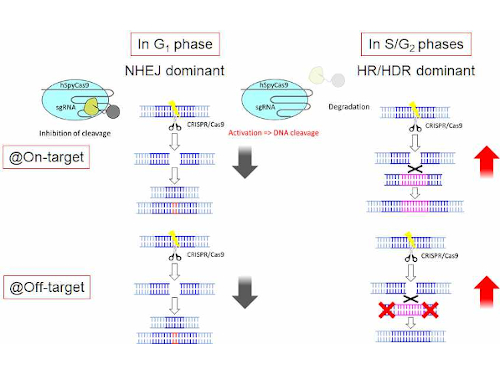By Hiroshima University Department of Public Relations
This photo shows the possible mechanism of increased homology-directed repair efficiency and suppression of off-target effects by controlled activation of CRISPR-Cas9 depending on the cell cycle phase.
A group of researchers developed a promising fix to CRISPR-Cas9’s problem with unwanted genetic changes using a method that allows them to turn off gene-editing until it reaches key cell cycle phases where more accurate repairs are likely to happen.
Researchers from Hiroshima University and Tokyo Medical and Dental University published on Communications Biology the results of their study which successfully demonstrated a more precise gene-editing and suppressed unintended genetic deletions, insertions, or mutations called off-target effects.
Although previous methods were developed that reported fewer off-target effects associated with the CRISPR technology, the researchers said these often exhibited lower editing efficiency.
“We aimed to develop the method to avoid the side effect called off-target effect which is one of the most challenging problems in the genome-editing field,” said Wataru Nomura, one of the study’s authors and a professor at HU’s Graduate School of Biomedical and Health Sciences.
“Our method is like hitting two birds with one stone. We can improve the preciseness of genome editing and suppression of off-target effects at the same time.”
More control in gene-editing
CRISPR-Cas9 has ushered in a new frontier in gene editing as a simpler and less expensive tool. Acting like scissors, it can snip genetic material you want to alter. The process, however, can also create off-target effects that limit its use in the field of therapeutics.
The newest method developed to eliminate off-target effects works by using the anti-CRISPR protein AcrIIA4 which works like an “off switch” that stops the genome editing activity of SpyCas9. The researchers fused AcrIIA4 with the N terminal region of human Cdt1 — a gene that helps ensure DNA replication happens only once per cell division — intending to deactivate gene editing until S and G2, phases of the cell cycle when homology-directed repair (HDR) is dominant.
HDR is one of the two DNA repair processes used by organisms along with non-homologous end joining (NHEJ). Of the two, however, HDR is the preferred method as the repair relies on the existence of two chromosome copies in each cell. HDR’s use of the duplicate chromosome as a template for repair makes gene editing more precise as opposed to NHEJ which just tends to connect the broken ends of the DNA. HDR occurs during the S and G2 phases of the cell cycle while NHEJ operates in all phases, especially in G1 — the first phase of the cycle’s interphase stage where the cell grows in preparation for DNA replication.
The researchers found that the amount of ArIIA4-Cdt1 fusion is dependent on the cell cycle. It increases during the G1 phase which stops gene-editing from happening and, consequently, halts repairs through NHEJ. Meanwhile, it decreases during the S, G2, and M phases that follow.
“The efficiency of HDR using AcrIIA4-Cdt1 was increased approximately by 4.0-fold compared to that using SpyCas9 alone. At target or off-target site 1 (HCN1 gene), the mutation ratio was decreased by 86.5%. Moreover, the mutation ratio at off-target site 2 (MFAP1 gene) was decreased from 8.5% to 0.6% using AcrIIA4-Cdt1,” the researchers said in the study.
“Co-expression of SpyCas9 and AcrIIA4-Cdt1 not only increases the frequency of HDR but also suppresses off-target effects. Thus, the combination of SpyCas9 and AcrIIA4-Cdt1 is a cell cycle-dependent Cas9 activation system for accurate and efficient genome editing.”
Nomura said they want to further improve the preciseness of the system so it could be used safely in the therapeutic field.
“We envision to apply our system to other CRISPR/anti-CRISPR combinations as well as other CRISPR based gene editor such as base editors and targeted transcription mediators,” he said.
“Our ultimate goal is to develop a genome editing system which can be used safely in the medical therapeutic field.”
(Research news authored by Mikas Matsuzawa)
Matsumoto, D., Tamamura, H. & Nomura, W. A cell cycle-dependent CRISPR-Cas9 activation system based on an anti-CRISPR protein shows improved genome editing accuracy. Commun Biol 3, 601 (2020). https://doi.org/10.1038/s42003-020-01340-2

 Home
Home















